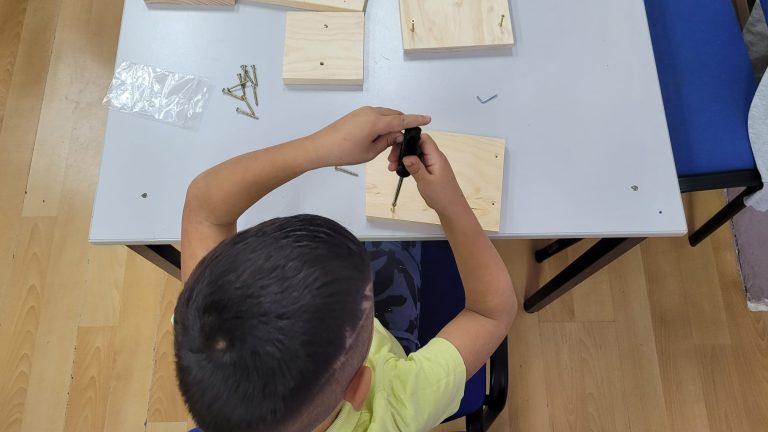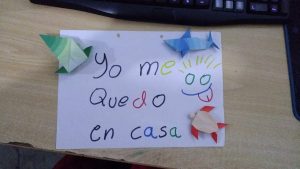
We know nature through Nest Boxes
We know nature through Nest Boxes


Madrid, Spain - Connecting children and their families with nature is a priority for the Education and Development Foundation, which recently organized the educational activity "We get to know Nature through the Nesting Boxes" in Miraflores de la Sierra, Madrid. The event brought together 22 boys and girls from the playgroup in the Zofío neighborhood of Usera, who, together with their fathers and mothers, participated in this experience aimed at the protection of migratory birds and the development of environmental awareness.
The initiative aimed to encourage respect and understanding of biodiversity in children through the construction, decoration and placement of nest boxes for migratory birds. The boxes, made of wood and coming from an association that collaborates with teenagers with Down syndrome, were decorated by the children and their families for two weeks, during which they dedicated themselves not only to assembling the houses, but also to filling them with color. and personality, even giving names to the “future inhabitants.” “Decorating the houses was their favorite activity,” said one of the participating parents, highlighting the children's joy in bringing these bird havens to life.
The Trip to Miraflores de la Sierra: Connection with Nature and the Countryside
On the day of departure, a bus managed by the Foundation took the participants to Miraflores de la Sierra. During the journey, the boys and girls shared stories and songs organized by the Foundation's volunteers, while the parents joined in the lively conversation. For many of the children, it was the first time in the countryside, and they excitedly observed animals such as cows, sheep and bulls along the way, expressing surprise and curiosity at the natural wealth that surrounded them.
The first stop was at the Foundation's headquarters, where they were received by professor and biologist Juan Linaza, who is also a beekeeper and an environmental education enthusiast. Linaza welcomed and explained the following activity: each boy and girl had to find a tall tree, facing south, to hang their nest box, a strategic position so that the birds can better adapt to the environment. The activity, which combined fun and learning, excited the little ones, who placed their boxes on the trees with great enthusiasm.



Reforestation and Games with the Flock
The project continued with a reforestation activity. Using picks and shovels, participants planted oak acorns and pine nuts and transplanted small trees around the plot. The Foundation highlighted the importance of this task in its mission to educate new generations in sustainable practices and care for the environment. For the children, this experience was an opportunity to get their hands dirty and understand the value of each tree in the ecosystem.
Later, they visited the sheep barn, where the children had fun running and playing with the flock, taking advantage of the freedom of being in an open, natural space. This connection with animals and nature is part of the values that the Education and Development Foundation seeks to transmit through its projects, inspiring children to feel part of the environment that surrounds them.
A Story at the Priest's Fountain: Learning with Legends and Ancestral Sounds
The next stop was the Fuente del Cura, a small valley on the outskirts of the town, where the children enjoyed a mystical story told by Gary Aranda, a storyteller from Ayacucho, Peru, who was visiting Spain. This story, full of magical and natural elements, captured the imagination of the boys and girls, who listened attentively. After the story, Aranda presented a pre-Columbian instrument that emitted a sound through the movement of water, awakening the curiosity of the children, who asked questions about its operation and origin. This experience not only enriched learning, but also expanded their vision of cultures and history.
At the end of the activity at the Fuente del Cura, it was time for food. The families, organized in small groups, reflecting on the experiences lived and the bond created between the participants. During this break, parents also took the opportunity to comment on the importance of the activity and the positive impact it had on their children. This connection between families reinforces the Foundation's commitment to creating spaces where both adults and children learn to care for nature, strengthening the sense of community and shared responsibility.
The Return: A Farewell with a Wish for a Repeat
The last stop before returning was at the Miraflores de la Sierra stream, where Linaza led the group on a final walk. Upon returning to the bus, the children, exhausted after a day full of activities, fell asleep during the return trip. Upon arriving at the Usera playgroup, they said goodbye with hugs and wishes to live a similar experience again.
Importance of Environmental Education in Childhood
Activities such as “We get to know Nature through the Nest Boxes” are fundamental in the educational approach of the Education and Development Foundation, which seeks to raise awareness among children about the importance of caring for the environment. Building and decorating nest boxes for migratory birds, along with planting trees, are simple but powerful actions that teach children the value of life and the impact each one can have on nature. In this sense, environmental education becomes an essential pillar to promote conscious and responsible citizens with their environment.
Juan Linaza, who has collaborated in this and other activities of the Foundation, highlighted the need to involve the little ones in conservation projects. “When children plant a tree or build a bird house, they are actively participating in caring for nature, and this learning is essential for respect and ecological awareness to take root from an early age,” he noted.
In conclusion, this activity not only provided children and their families with a unique learning and coexistence experience, but also reaffirmed the commitment of the Education and Development Foundation in its work to create environmental awareness and promote respect for biodiversity. The day in Miraflores de la Sierra left a significant mark on each participant, with the promise of continuing to strengthen this educational mission in future activities and environmental projects.
Reasons to place Nest Boxes
- They provide birds with safer places for breeding and shelter, reducing nest predation.
- They provide nesting places for species where there are none naturally in cavities.
- They facilitate the recovery of threatened species, improving the diversity of the ecosystem.
- They enhance the conservation of birds, providing biological control against possible pests such as mosquitoes. With them, the use of insecticides that are harmful to the environment is reduced.
- They give rise to scientific studies, providing data to different investigations of animal behavior, bioindicator species, etc.
- They provide a good space for nature lovers to observe these birds, take photographs, environmental education, etc. We must always keep in mind that, if we intend to take care of something, better results are obtained if you know it, if you like it or have seen it.
- Visiting and enjoying natural spaces contributes to improving our health and feeling better about ourselves.
- They allow biodiversity to be enhanced and the environment improved, promoting a project for everyone and contributing to service learning.

Education and Development Foundation
Prof. Juan Linaza - member of the board of the Education and Development Foundation of Spain.
About us
We are a non-profit institution that defends children's right to play. For 30 years we have been generating and sustaining spaces and times in which play and the playful role of childhood are respected. We claim outdoor play spaces and promote environmental education that allows us to enjoy and care for nature.
Other News
Facebook page
FED NEWS

Know us:
It was established in Madrid on February 8, 1994 and registered in the registry of foundations of the Ministry of Education with No. 247 by ministerial order; on April 6 of the same year it was published in the state bulletin.
The last:



School Playgroups and their impact on coexistence between students



